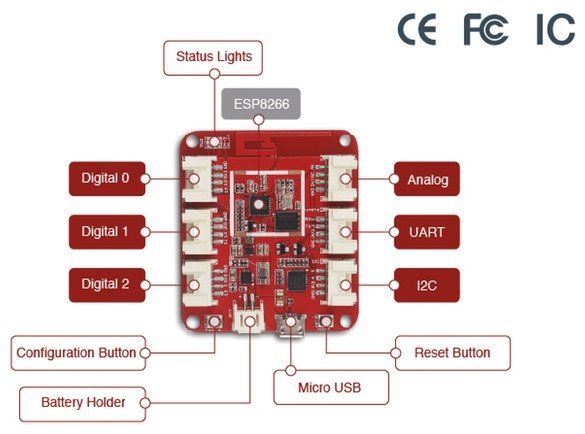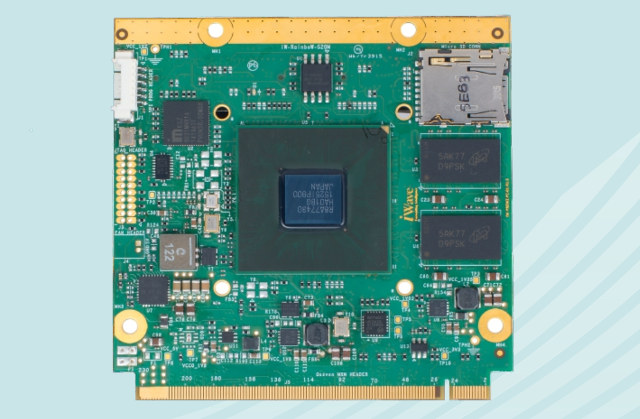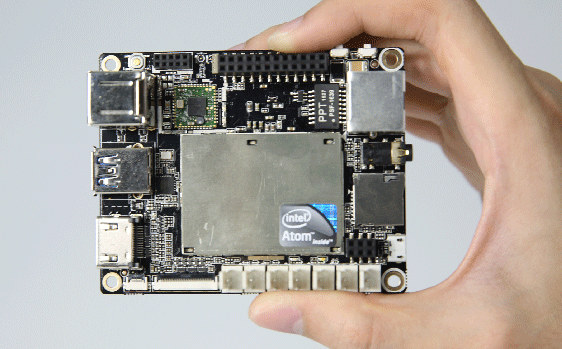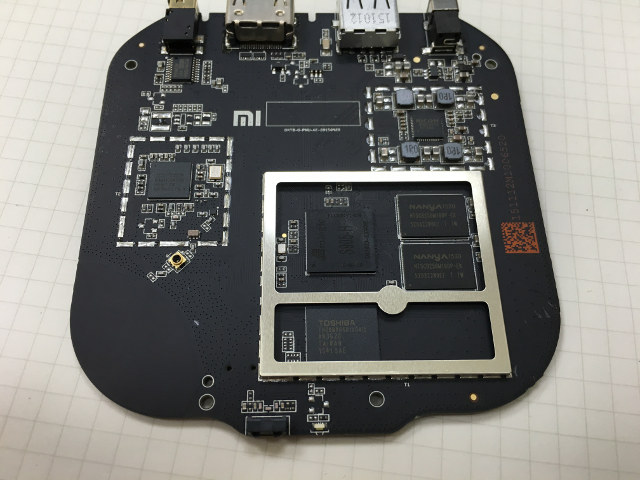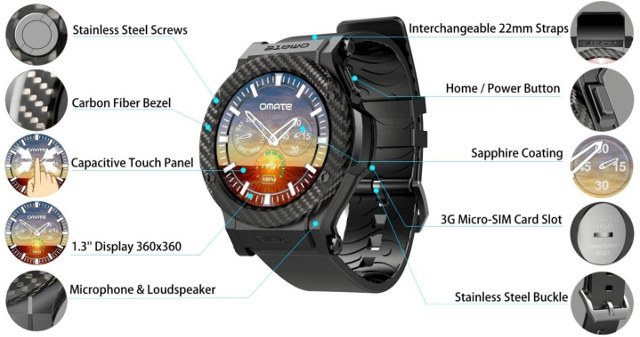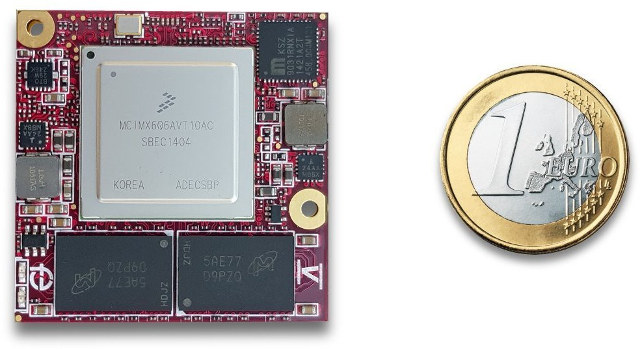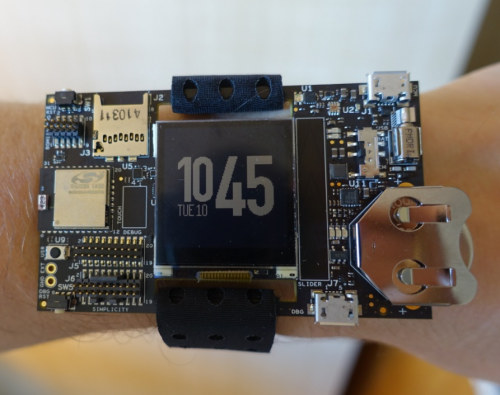There are already plenty of board or modules based on Espressif ESP8266 WiFi SoC, but if you don’t like soldering, or would rather avoid breadboards and some cables for your or your kids’ projects, Wio Link may be interesting, as all you need to is to connect Grove modules required for your applications to get started, and Seeed Studio also took care of the low level software part and a drag-and-drop mobile app is provided, so software programming has been made easy too. Wio Link hardware specifications: SoC – Espressif ESP8266EX Tensila SoC Storage – 4MB flash Connectivity – 802.11b/g/n WiFi, with WEP/TKIP/AES encryption support Expansion – 6x Grove connectors: 3x digital, 1x analog, 1x UART and 1x I2C (3.3V I/Os) Power Supply 5V via micro USB port 3.4 ~ 4.2V via external battery Output DC Current – 1000mA MAX Charge Current: 500mA MAX Dimensions – 55mm*48mm Weight – 26g […]
Sonoff & Slampher are $5 RF and WiFi Smart Switches and Lightbulb Adapters (Crowdfunding)
ITEAD Studio has launched two new low cost home automation products with Sonoff smart switch, and Slampher smart E27 light bulb adapter both supporting control via WiFi and your Android smartphone, or 433MHz with a simple remote control, while still retaining the capability to control your electrical appliances and lights with a manual switch. Installation is pretty easy, and safer than some other products like Semlamp. Sonoff – You simply need to cut the cable to your appliance, and insert two wires into the IN part, and the other two wires into the OUT part. Turn if on, and add it to the app if you are going to use a smartphone Slampher – Remove your light bulb from its current socket, screws the bulb to Slampher, and put it back into your socket. Register the light in to the app and your done. Both devices will send data to […]
iWave Systems iW-RainboW-G20M-Q7 SoM Features Renesas RZ/G1M Cortex A15 SoC
iWave Systems has unveiled a new Qseven 2.0 compliant system-on-module part of their RainboW family with iW-RainboW-G20M-Q7 module powered by Renesas RZ/G1M dual core ARM Cortex A15 SoC, and targeting industrial and automotive applications with over 10 years of support. iW-RainboW-G20M-Q7 module specifications: SoC – Renesas RZ/G1M dual core ARM Cortex A15 @ 1.5GHz with PowerVR SGX544MP2 GPU @ 520MHz System Memory – 1GB DDR3(expandable) Storage – 4GB eMMC Flash (expandable) + 2MB SPI NOR Flash for boot code, and optional Micro SD Slot Connectivity – 1x Gigabit Ethernet PHY USB – 2 Port USB HUB I/Os via 230-pin Qseven edge connector: Storage – 1x SATA , 1x SDHC USB – 1x USB3.0 host, 2x USB 2.0 hosts, or 1x USB 2.0 device Display – 1x LVDS Connectivity – 1x Gigabit Ethernet Audio – 1x I2S Audio 2x PWM, 2x I2C, SPI, CAN, UART, GPIOs 1x PCIe (multiplexed with SATA) JTAG or […]
LattePanda is a $79 Arduino Compatible Intel Atom x5 Board Running Windows 10 (Crowdfunding)
I feel like I’m living in another world after writing a title combining Arduino, Intel and Windows 10, but that’s exactly what LattePanda is promising with a development board featuring both an Intel Atom x5-Z8300 processor and an Atmel AVR MCU, and Windows 10 as the operating system. LattePanda board specifications: SoC – Intel Atom x5-Z8300 “Cherry Trail” quad core processor @ 1.44 GHz (Burst frequency: 1.84 GHz) with Intel Gen8 HD graphics @ 500 MHz System Memory – 2 to 4 GB DDR3L Storage – 32 or 64 GB eMMC, micro SD slot MCU – Atmel Atmega32u4 micro-controller Video Output / Display – HDMI, and MIPID DSI connector Audio I/O – HDMI, 3.5mm audio port Connectivity – Ethernet, WiFi and Bluetooth 4.0 USB – 1x USB 3.0 port, 2x USB 2.0 host ports, 1x micro USB port for power Serial – 1x from Intel SoC, 1x from Atmel MCU […]
Xiaomi Mi 3 TV Box Board’s Pictures Reveal Amlogic S905-H Processor
Xiaomi unveiled Mi 3 TV box based on Amlogic S905 processor a while ago, but since we’ve got so many Amlogic S905 boxes on the market, and the interface is only in Chinese, I did not find it that interesting. But somebody did a teardown of the device, and sent me some good pictures revealing that the device uses Amlogic S905-H with DTS and Dolby licenses paid for and enabled. So that means just like for Amlogic S812, where there’s a S812-H with Dolby and DTS, there are two versions for Amlogic S905. I understand the silicon might be the same, but the SDK will differ (TBC). Other main components include a 4GB Toshiba THGBMBG5D1KBAIT eMMC 5.0 flash, two NANYA NT5CB256M16DP-EK 512MB DDR3 chips (1GB in total), a Broadcom wireless chipset (BCM4345) for 802.11ac Wifi and Bluetooth 4.1, and Ricoh RN5T567A PMIC. There are few connectors as on other Xiaomi […]
Omate Rise is a $199 3G and WiFi Smartwatch Powered by Mediatek MT2601 SoC (Crowdfunding)
Most smartwatches sold on the western markets are designed to be smartphone’s companions, and only come with Bluetooth LE connectivity, while we’ve seen many smartwatches (aka watchphones) with SIM card slot originating from China in the past, including the lower end No.1 D3 smartwatch which I reviewed recently. But this may be changing, as Omate is going to launch a new smartwatch called Omate Rise that will include 3G connectivity via a micro SIM card slot, as well as WiFi, Bluetooth Smart, and GPS. Omate Rise specifications: SoC – Mediatek MT2601 dual core ARM Cortex A7 @ 1.2GHz with ARM Mali-400 MP GPU System Memory – 512MB RAM Storage – 4GB flash Display – 1.3″ round muti-touch color display with 360×360 resolution (Innolux) Connectivity – Bluetooth 4.1 LE (A2DP profile), WiFi 802.11 b/g/n, GPS Cellular Connectivity – 3.5G HSDPA (2100/1900 MHz), GPRS / EDGE /GSM (850/900/1800/1900 MHz); micro SIM card […]
iMX6 TinyRex Module and Development Board Support HDMI Input in Linux (Video Demo)
A couple of years ago, I wrote about iMX6 Rex open source hardware project combining a Freescale i.MX6 SoM and baseboard that aimed a teaching hardware design (schematics and PCB layout). I had not followed the project very closely since then, until I watched a video showcasing HDMI input capabilities in Linux using the new version of the module and baseboard called i.MX6 TinyRex. i.MX6 Tiny Rex module specifications: SoC – Freescale iMX6 processor up to 1.2GHz and 4 cores System Memory – Up to 4GB DDR3-1066 (533MHz) Storage – EEPROM Connectivity – 10/100/1000 Mbps Ethernet PHY I/Os via 3 board to board connectors: Display / Video Output 1x HDMI (up to QXGA 2048×1536) 1x LVDS (up to WUXGA 1920×1200) 1x 20-bit parallel LCD display (up to WXGA 1366×768) or 1x Video Input (CSI) 1x MIPI DSI differential display output (up to XVGA 1024×768) Video Input 1x 20-bit parallel video input […]
Thunderboard Wear is a $75 Smartwatch Development Board by Silicon Labs
A few days ago I watched an ARMDevices.net’s video about an ARM’s smartwatch reference design running mbed OS 3.0, powered by a Silicon Labs EFM32 Giant Gecko Cortex M3 MCU, and promising up to 2 months battery life on a 160 mAh battery. While I could not find the full details about the reference design, I noticed Silicon Labs also launched a development board called Thunderboard Wear, based on the same platform, just quite bigger, and still wearable… (Sort of) Thunderboard Wear specifications: MCU – Silicon Labs EFM32GG995F1024 ARM Cortex-M3 MCU up to 48 MHz with 128 kB RAM,1 MB Flash External Memory – 256 kB external SRAM External Storage – micro SD card slot Display – 128×128 pixel Memory LCD from Sharp Connectivity – Bluetooth 4.1 smart module (Silicon Labs BGM111), upgradeable to Bluetooth 4.2 Sensors Ambient Light Sensing (ALS) and Proximity/Gesture via Silicon Labs Si1141. Optical hear-rate monitoring […]


